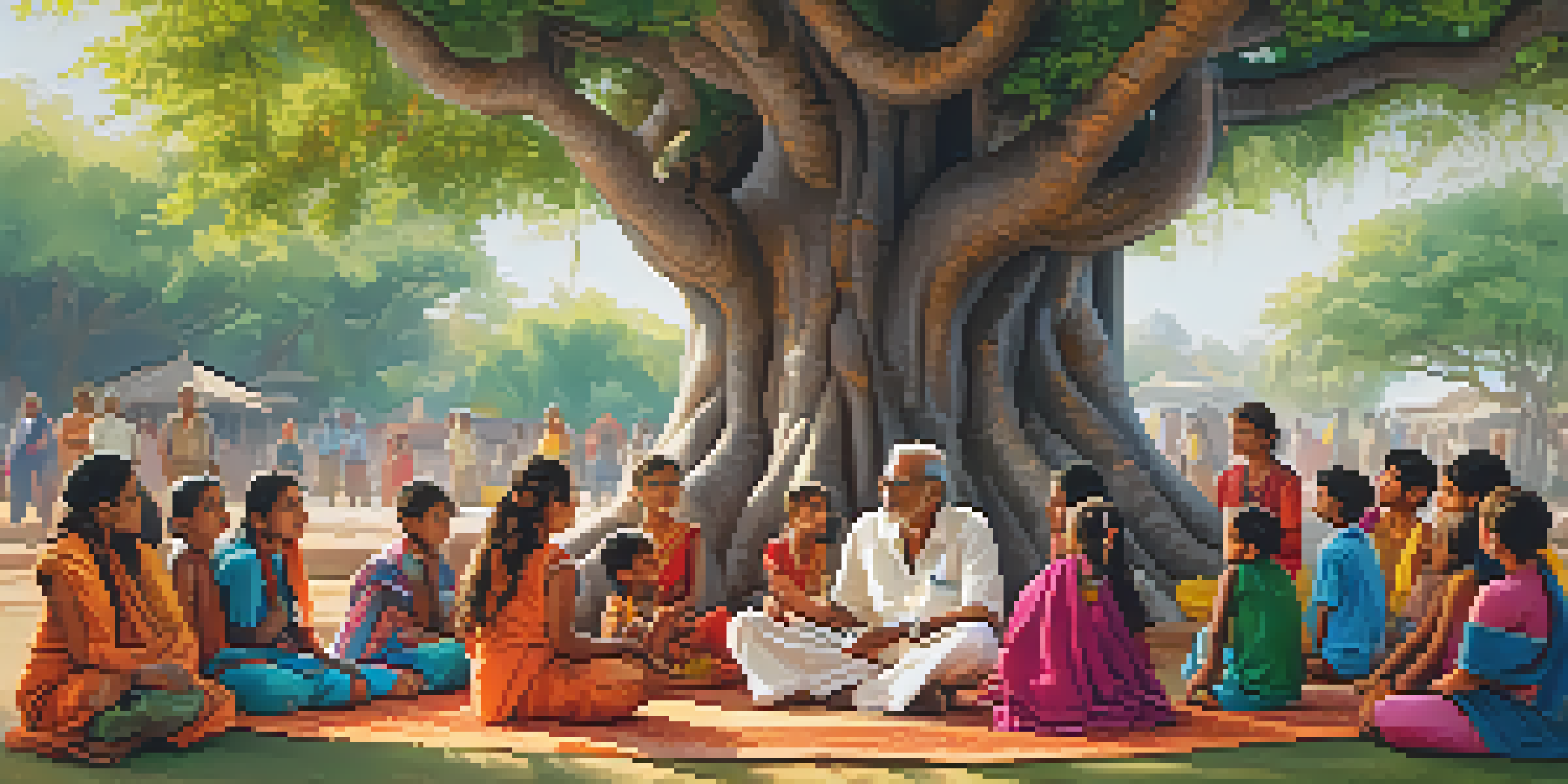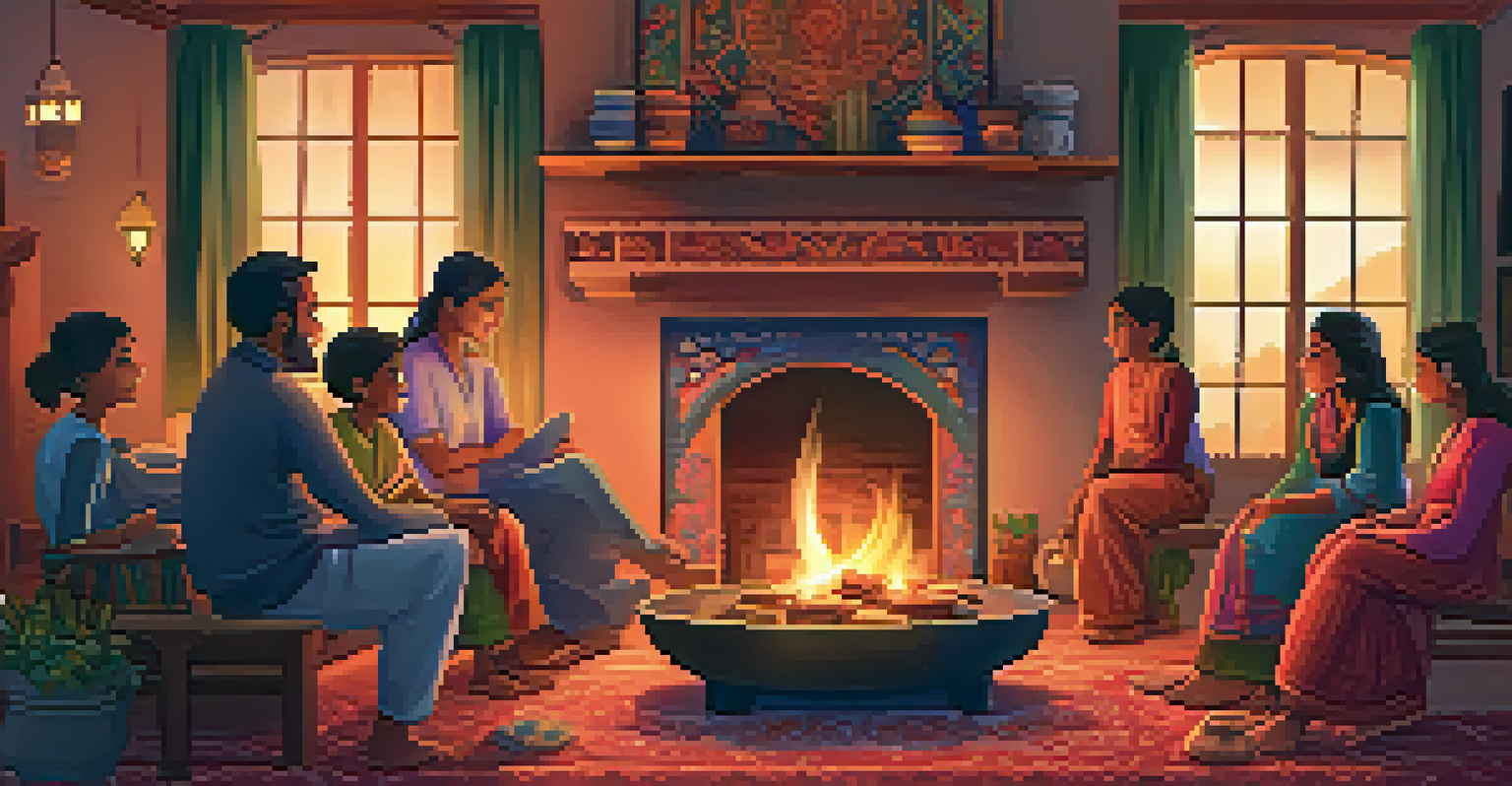Art of Storytelling in Indian Culture: Heritage Through Folklore

Understanding the Role of Folklore in Indian Culture
Folklore is the heartbeat of Indian culture, weaving together myths, legends, and tales that reflect the values and beliefs of different communities. These stories often carry moral lessons, historical events, or cultural practices, passed down through generations. In a country as diverse as India, folklore acts as a unifying thread, connecting people across regions and languages.
Folklore is the heart of a community, a way for people to connect, share their experiences, and understand their culture.
From the vibrant tales of the Mahabharata to local legends about deities and spirits, folklore serves as a mirror to society, showcasing its hopes, fears, and dreams. These narratives are not just entertainment; they provide insight into the social fabric and collective identity of communities. Understanding folklore is essential to grasp the nuances of Indian culture and its historical significance.
Moreover, storytelling is an art form in itself, with each teller bringing their own flair to the tales. This oral tradition fosters creativity and preserves the rich cultural tapestry of India, ensuring that each generation inherits the wisdom and experiences of its predecessors.
The Various Forms of Storytelling in India
Storytelling in India encompasses a rich variety of forms, ranging from oral traditions to theatrical performances. Oral storytelling, often performed by village storytellers, involves engaging the audience through songs, gestures, and dramatic expressions. This interactive style captures the attention of listeners, making them a part of the story.

In addition to oral narratives, India boasts theatrical forms like Kathakali and Yakshagana, which combine storytelling with dance and music. These performances not only entertain but also educate audiences about moral values and cultural history. Each art form adds a unique flavor to the stories, highlighting the regional diversity and artistic expression found across the country.
Folklore Connects India's Diversity
Folklore serves as a unifying thread, reflecting the values and beliefs of diverse communities across India.
Furthermore, modern mediums, such as cinema and literature, have adapted traditional tales, bringing them to new audiences. By blending the old with the new, these adaptations continue to keep folklore alive, ensuring its relevance in contemporary society.
The Significance of Myths and Legends in Indian Folklore
Myths and legends play a crucial role in Indian folklore, often serving as the foundation for cultural beliefs and practices. These stories usually revolve around gods, heroes, and mythical creatures, exploring themes of good versus evil, love, and sacrifice. They help to explain the unexplainable, providing a sense of understanding in a complex world.
Stories are the threads that weave together the fabric of our lives; they connect us to our past and guide us into the future.
For instance, the stories of Lord Rama and Lord Krishna are not just religious texts but also reflect ideals of duty, righteousness, and devotion. These tales offer moral guidance, inspiring individuals to uphold virtues in their daily lives. The characters become archetypes that resonate with people, making them timeless and universally relatable.
Moreover, these myths are deeply intertwined with festivals and rituals, enriching spiritual practices and community celebrations. As people gather to recount these stories, they strengthen social bonds and reinforce cultural identity, ensuring that these narratives live on.
Regional Variations in Indian Folklore
India's vast diversity means that folklore varies significantly from region to region. Each state has its own unique tales that reflect local customs, traditions, and languages. For example, the folktales of Punjab often revolve around valor and heroism, while those from Kerala may focus on supernatural elements and moral lessons.
These regional stories provide a glimpse into the daily lives and struggles of people, often drawing on local geography and culture. They may involve familiar characters, such as farmers, kings, or mythical beings, which resonate strongly with the audience. This localized storytelling fosters a sense of pride and belonging among community members.
Storytellers Preserve Cultural Heritage
Storytellers play a vital role in preserving and sharing folklore, ensuring these narratives remain vibrant and engaging.
Furthermore, the oral tradition allows for continual evolution, as storytellers adapt tales to suit contemporary contexts while retaining their core essence. This dynamic nature of folklore keeps it relevant, allowing new generations to connect with their heritage while exploring their own identities.
The Role of Storytellers in Preserving Folklore
Storytellers are the custodians of folklore, playing a vital role in preserving and sharing these narratives. Often revered in communities, they are tasked with passing down stories in a manner that captivates and engages audiences. Their ability to breathe life into tales ensures that traditions are not lost to the passage of time.
In many cases, storytellers use their unique voices and styles to create a connection with listeners, transforming stories into immersive experiences. This relationship fosters a sense of community, as people gather to listen and share in the joy of storytelling. Through this communal experience, folklore becomes a living tradition, continually evolving with each retelling.
Additionally, the resurgence of storytelling festivals and workshops has highlighted the importance of these artists. As society shifts towards a digital landscape, these events create spaces for traditional storytelling to thrive, ensuring that the art form remains vibrant and relevant for future generations.
The Impact of Modern Technology on Storytelling
In the digital age, technology has transformed the way stories are told and shared. Social media platforms, podcasts, and streaming services have opened up new avenues for storytellers, allowing them to reach larger audiences than ever before. This shift not only broadens the reach of traditional folklore but also encourages innovation in storytelling techniques.
While technology offers exciting possibilities, it also poses challenges. The authenticity of oral traditions may be at risk as stories become commercialized or adapted for mass consumption. However, many storytellers have embraced these changes, finding ways to blend traditional elements with modern formats, thus keeping the essence of folklore alive.
Modern Tech Transforms Storytelling
The digital age has revolutionized storytelling, allowing traditional tales to reach broader audiences while blending old and new techniques.
Moreover, the rise of digital storytelling has led to the creation of new narratives that reflect contemporary issues. As storytellers harness the power of technology, they can address current social challenges while honoring their cultural heritage, creating a rich tapestry of stories that resonate across generations.
Preserving Folklore for Future Generations
As custodians of culture, it is imperative to preserve folklore for future generations. This preservation involves documenting stories, conducting research, and supporting local storytellers. By recording these narratives, we can ensure that the wisdom and experiences of past generations are not lost but instead serve as a foundation for future learning.
Educational institutions and cultural organizations play a crucial role in this endeavor. By incorporating folklore into curricula and community programs, they foster a sense of appreciation for these stories among younger audiences. Engaging children with tales from their heritage can inspire a sense of identity and belonging.

Ultimately, the preservation of folklore is a collective responsibility. By sharing stories across generations, we can keep the art of storytelling vibrant and alive, ensuring that the rich tapestry of Indian culture continues to inspire and connect people for years to come.